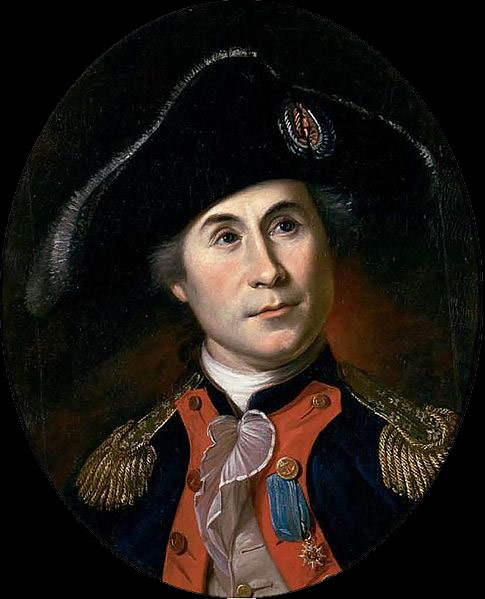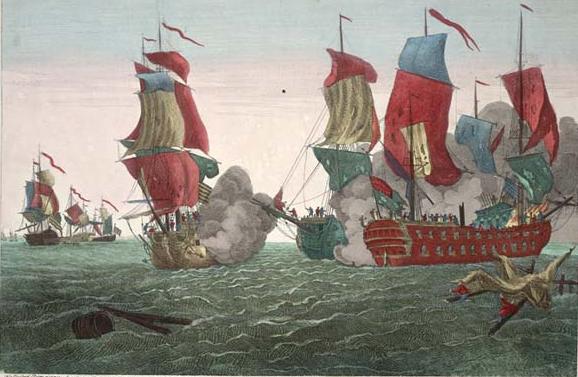 John Paul Jones was born John Paul on July 6, 1747 in the Stewartry of Kirkcudbright in Scotland. The “Jones” was a fanciful later addition for unknown reasons while he was living in America. His father (also John Paul) was a gardener. He started his career as a sailor at the age of 13, with voyages from Whitehaven in Cumberland, England and Fredericksburg, Virginia, where his older married brother had settled, as a common destination. He initially sailed on several slave ships and early rose to the rank of first mate in 1766 – a sign of uncommon ability in one so young (he was only 19 years old). He later grew disgusted with the unsavory slave trade and abandoned his position in Jamaica, finding his own way back to Scotland.
John Paul Jones was born John Paul on July 6, 1747 in the Stewartry of Kirkcudbright in Scotland. The “Jones” was a fanciful later addition for unknown reasons while he was living in America. His father (also John Paul) was a gardener. He started his career as a sailor at the age of 13, with voyages from Whitehaven in Cumberland, England and Fredericksburg, Virginia, where his older married brother had settled, as a common destination. He initially sailed on several slave ships and early rose to the rank of first mate in 1766 – a sign of uncommon ability in one so young (he was only 19 years old). He later grew disgusted with the unsavory slave trade and abandoned his position in Jamaica, finding his own way back to Scotland.
He found another position, but his career received a rapid boost when the captain and senior mate of his ship both died of yellow fever and he managed to navigate his way back to harbor. As a reward he was made master of the ship and made two voyages to Jamaica. On the second voyage he had a sailor severely flogged. The man later died. This incident ruined his reputation. He left Scotland and captained a vessel (the “Betsy”) registered in London on speculative voyages to Tobago. This phase of his career ended when he killed a mutineer with a sword. He fled to Fredericksburg, Virginia, abandoning all of his money.
Life in America
In Fredericksburg he arranged the affairs of his brother, who had recently died. It was here that he adopted the “Jones”, perhaps in honor of Willie Jones, of North Carolina. He also soon joined the new Continental Navy to fight against Britain. His early experiences had prepared him well to be a bold and determined naval commander, capable of acting independently – just the sort of officer most needed by the fledgling navy. His reasons for doing so are not clearly known. He would have been around 28 years old at the time, but was an experienced skipper of many years.
He sailed from the Delaware River in February, 1776 aboard the Alfred on the maiden cruise for the nascent Continental Navy. He had the honor of being the first to raise the Grand Union Flag – later to be replaced by the now familiar Flag of the United States. This fleet, although originally intended to do a training coastal cruise, was led to the Bahamas by Commodore Esek Hopkins where Nassau was raided for its supplies. Jones was next appointed to command the sloop “Providence” in exchange for command of one of the 13 frigates under construction. During a six-week voyage, John Paul Jones captured 16 prizes and inflicted considerable damage during raids on the coast of Nova Scotia. On November 1, 1776 Jones set sail in command of the “Alfred” to liberate American prisoners in coal mines in Nova Scotia and to raid British shipping in the area. Although unable to raid the coast due to weather conditions, he did manage to capture a ship.
Command of the Ranger
As a result of his disagreements with Commodore Hopkins, Jones was given command of the smaller, newly-constructed Ranger (on the same day as the new Stars and Stripes flag was adopted). He then set sail for France to disrupt British shipping and cause as much damage as possible. In France he was assigned command of “l’Indien,” a new ship building for America in Amsterdam. She was sold to France instead. During this period he is thought to have developed a close friendship with Benjamin Franklin. On February 6, 1778, France signed the Treaty of Alliance with America, and Ranger became the first American vessel to be saluted by the French Navy, with a nine-gun salute.
Jones then sailed from Brest, France for the Western coast of Britain. At this stage, the relative inexperience of his crew and officers and the lack of a strong tradition was revealed. The officers did not maintain proper discipline, encouraging the crew to question orders and inciting disobedience. Being poor, they saw themselves in the role of privateers, and were excited at the prospects of wealth from the raids. An initial raid on Whitehaven was rendered impossible by weather conditions, and instead Ranger disrupted British shipping off the coast of Ireland. An attempt on an anchored sloop, HMS Drake, failed due to the indiscipline of a mate, Jones the sailed back to raid Whitehaven. Here an attempt to set fire to ships grounded in harbor was thwarted, although Jones’ foresight in first spiking defensive guns covering the harbor as a prelude to the main attack, proved its worth.
An attempt to kidnap the Earl of Selkirk from his estate on St Mary’s Isle near Kirkcudbright and exchange him for American prisoners failed due to his absence at the time. His crew wished to pillage and destroy the estate, but Jones would only allow the seizure of a set of silver plate, which he later bought back in France and returned to the Earl. His officers and crew were still mainly motivated by prospects of plunder. Although these attacks caused a reorganization of defenses and disrupted shipping, no profits were made to be shared with the crew, who still regarded themselves as being a privateer instead of an actual warship.
On returning to France thru the Irish Sea, Ranger attacked and captured HMS Drake, a vessel of roughly the same size, and she was subsequently sailed back to France by Ranger’s Lieutenant Simpson. Ranger then took another prize and brought it back to France as well. On arrival in France, there was some controversy between John Paul Jones and Lieutenant Simpson, which might have been caused by an attempt by Jones to seize all the glory for himself. This was smoothed over by John Adams.
Bonhomme Richard
 In 1779, Jones was given command of the Bonhomme Richard, a converted merchant ship with 42 guns which was given to America by a French shipping owner. On August 14 of that year, he set sail with a 5-ship squadron accompanied by two privateers to provide a diversion for an approaching fleet of French and Spanish ships which was approaching England. His intention was once more to raid the Irish Sea area. Several Royal Navy ships were sent in pursuit, but he sailed right around the tip of Scotland and caused consternation all along the east coast of England as far South as the Humber estuary.
In 1779, Jones was given command of the Bonhomme Richard, a converted merchant ship with 42 guns which was given to America by a French shipping owner. On August 14 of that year, he set sail with a 5-ship squadron accompanied by two privateers to provide a diversion for an approaching fleet of French and Spanish ships which was approaching England. His intention was once more to raid the Irish Sea area. Several Royal Navy ships were sent in pursuit, but he sailed right around the tip of Scotland and caused consternation all along the east coast of England as far South as the Humber estuary.
On September 23, he met up with a large British merchant convoy, whose escorts placed themselves between his squadron and the rest of the convoy to allow the merchant ships to escape. In the evening, the Battle of Flamborough began when the Bonhomme Richard engaged the HMS Serapis, a 50-gun frigate. During the ensuing battle, where various ships on both sides engaged, the famous incident occurred when Bonhomme Richard’s ensign was shot away and Serapis’ captain asked if they had struck their colors. John Paul Jones replied, “I have not yet begun to fight!” HMS Serapis and other British ships were forced to surrender. Bonhomme Richard could not be saved and Jones took command of Serapis and sailed her to Holland.
Chevalier Jones
He was invested with the title of Chevalier by the French King. He also received the decoration “l’Institution du Merite Militaire” and a sword. A later gold medal which was presented to him by Congress was inscribed with his title as Chevalier. He was given command of the America, but this ship was subsequently given to France as a replacement for the wrecked Le Magnifique. He ended up on an assignment to recover prize money due to his crew, and when this ran out, transferred to Russian service in 1788. He served successfully as a Rear-Admiral in the Russian fleet, but eventually left after unsubstantiated personal attacks.
Death and Legacy
He retired to Paris in 1790 and died of a kidney condition in 1792, before he could take up an appointment as Consul to treat with the Dey of Algiers.
His significance is that he entered a newly-born naval service and helped to found a proud tradition of service and professionalism as well as setting an example of inspiring valor. His name resounds proudly to this day in the vessels of the United States Navy. America is better for his example of service and patriotism. The example set by John Paul Jones has been proudly followed by many others over the years.